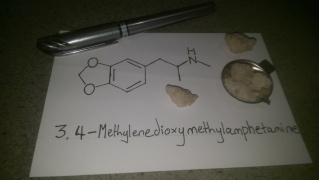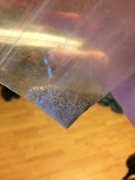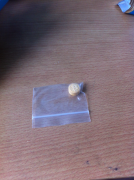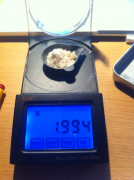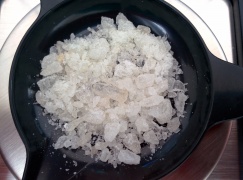MDMA
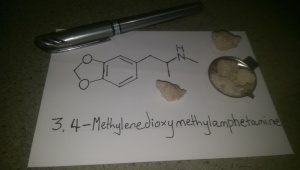
MDMA (3,4-methylenedioxy-N-Methylamphetamine) is an popular drug of the phenethylamine and amphetamine class known for its empathogenic, euphoric, and stimulant effects, and has also been used in psychotherapy. It most frequently comes in tablet form, although it is also found in capsules or as powder. MDMA is also known as Ecstasy, Molly, XTC, E and several other names.
Because MDMA is so popular and because it goes well with dance parties, the demand for it usually exceeds supply, especially at any given location on any given night. This creates an opening for unscrupulous individuals to sell virtually anything as 'ecstasy'. While 'ecstasy' is the popular name for MDMA, the functional definition of ecstasy is any pill represented as MDMA on the street. Ecstasy pills are notoriously unreliable in content, more so than most other street drugs, and commonly contain either caffeine, ephedrine, amphetamines, other MDXX's, DXM, or in rare cases DOX's, and don't necessarily contain MDMA or any psychoactive. They can also contain very neurotoxic substances (such as PMA, 4-CA, among many others). This problem has led to the development of simple MDMA Test Kits that may help give the user a general sense of the content of a pill.
The experience is often called rolling.
History
MDMA was first synthesized in 1912 by Merck chemist Anton Köllisch.
In the mid-1970s, Alexander Shulgin heard from his students about unusual effects of MDMA; among others, the drug had helped one of them to overcome his stutter. Intrigued, Shulgin synthesized MDMA and tried it himself in 1976. Two years later, he and David E. Nichols published the first report on the drug's psychotropic effect in humans. They described "altered state of consciousness with emotional and sensual overtones" that can be compared "to marijuana, and to psilocybin devoid of the hallucinatory component".
In the early 1980s the drug emerged in the parts of Europe and the United States.
MDMA was first proposed for scheduling by the Drug Enforcement Administration (DEA) in July 1984 and was classified as a Schedule I controlled substance in the U.S. on 31 May 1985; on an emergency basis. No double blind studies had yet been conducted as to the efficacy of MDMA for psychotherapy.
Dosage
| Light | 40-75mg |
| Common | 75-125mg |
| Strong | 125-175mg |
| Heavy | 175mg+ |
Duration
| Onset | 20-70 minutes |
| Peak | 2-3 hours |
| Total | 3-5 hours |
| After-effects | 2-24 hours |
Effects
Postive
- Mild to extreme mood lift, euphoria
- Increased willingness to communicate
- Increase in energy (stimulation)
- Ego softening
- Decreased fear, anxiety, and insecurities
- Feelings of comfort, belonging, and closeness to others
- Feelings of love and empathy
- Forgiveness of self and others
- A sense of inner peace and acceptance of self, others, and the world
- Increased awareness of senses (taste, smell, touch, hearing, vision)
- Life-changing spiritual experiences
- Analgesia, anti-nocioception, decreased pain perception
Neutral
- Decreased appetite
- Visual distortion
- Rapid, involuntary eye jiggling (nystagmus)
- Mild visual hallucinations (uncommon)
- Moderately increased heart rate and blood pressure (increases with dose)
- Restlessness, nervousness, shivering
- Change in body temperature regulation
- Upwellings of unexpected emotion, emotional lability
- Strong desire to do or want more when coming down
Negative
Negative side effects increase with higher doses and frequent use.
- Inappropriate and/or unintended emotional bonding
- Anxiety or paranoia (less common than opposite)
- Agitation (less common than opposite)
- Tendency to say things you might feel uncomfortable about later
- Mild to extreme jaw clenching (trisma), tongue and cheek chewing, and teeth grinding (bruxia)
- Short-term memory scramble or loss & confusion
- Short periods of swooning, or disconnection from the external world, usually at very high doses or during brief blasts of intense rushing while coming up.
- Muscle tension (common)
- Insomnia, inability to fall asleep when physically tired
- Erectile disfunction and difficulty reaching orgasm
- Increase in body temperature, hyperthermia, dehydration (drink water)
- Hyponatremia (don't drink too much water)
- Nausea and vomiting
- Headaches, dizziness, loss of balance, and vertigo
- Sadness on coming down, sense of loss or immediate nostalgia
- Post-trip crash - unpleasantly harsh comedown from the peak effect
- Hangover the next day, lasting days to weeks
- Possible strong urge to repeat the experience, though not physically addictive
- Possible psychological crisis requiring hospitalization (psychotic episodes, severe panic attacks, etc) (rare)
- Possible liver toxicity (rare)
- Neurotoxicity
- Small risk of death; approximately 2 per 100,000 new users have extreme negative reactions resulting in death (very rare)
Hangover
Many users report feeling extremely drained the day after MDMA use. This 'day after' effect means for many MDMA users that they need to plan 2 days for the experience: one for the peak experience and one recovery day, with very little planned. Many users also experience some level of post-MDMA depression, often starting on the second day after the experience and lasting for up to 5 days. A small percentage of users report depressive symptoms for weeks afterwards. Alternately, some users report feeling better than normal for a week or so after taking MDMA. The negative after-effects of taking MDMA appear to be worse with higher frequencies of use, higher dosages, and perhaps total lifetime usage.
Harm Reduction
- MDMA rapidly builds tolerance, depletes serotonin and compounds neurotoxicity issues. Look for other drugs and avoid using MDMA more than once every few months.
- Ecstasy tablets are notoriously impure, often containing chemicals other than MDMA. Check out EcstasyData and Pill Reports for pill testing results. Buy a Test Kit!
Health risks
As with many drugs, there are some serious risks associated with taking MDMA affecting people with existing health conditions, or in certain cases people who are otherwise very healthy. It is not advisable to take MDMA if any of the following apply to you:
- Health issues with the Heart, Kidneys or Liver
- High blood pressure
- History of having a stroke or heart attack
In rare cases MDMA can cause seizures, overheating, hypothermia, dehydration or water poisoning. It is important to keep an eye on body temperature and hydration while under the effects of MDMA.
There are some studies which suggest that long-term overuse and abuse of MDMA can cause or increase depression.
Interactions
- MDMA can cause Serotonin Syndrome when combined with MAOIs. Refer to Drug combinations for more information.
Chemistry and Pharmacology
Neurotoxicity, by Borax
- The neurotoxicity is well established, but studies are largely on mice and rats with higher dosages than humans tend to use.
- There is an excellent run through of the pharmacodynamics of MDMA neurotoxicity here.
- Overall what we know is that the neurotoxicity scales with dose, and is likely to do so exponentially as the body is caused to overheat more and has less anitoxidants to deal with metabolites.
- We don't have any quantitative estimates about damage from normal human doses because it would not be ethical to dose people repeatedly just to see how much it damages them, and it's very hard to gather data from regular users because of the huge number of variables like alcohol and cannabis use, sleep deprivation, environment of MDMA use etc.
- We know that long term users are not mentally impaired but those *abusing* the drug do show a reduced ability to enjoy it and suffer a more intense comedown, indicating that there is something going on at higher doses.
- Another discussion about MDMA neurotoxicity can be found here.
MDMA purity myths, by Borax
The 84% claims are based around either a poor understanding of the science or are a deliberate attempt to pass off inferior product as high quality.
You should read this discussion, but basically if anyone claims their MDMA is 84% pure then they have performed no analysis at all and should not be trusted.
With almost all, the name is an abbreviation for Drug.salt. In the case of MDMA, it is MDMA.HCl, amphetamine is usually amphetamine.H2SO4 and LSD is LSD.tartrate. Because these forms are ubiquitous, nobody bothers to mention the second bit because it's irrelevant. All doses you see for MDMA are referring to the HCl salt, which means that MDMA which is sold as "the purest you can get, 84%", is treated as 100% pure.
The reason sellers do this is because they usually don't have very pure MDMA, and they want people to make the mistake you have made and take more to account for crappy product. It is dishonest, confusing and misleading and if you have a choice you should avoid this vendor.
Production
MDMA is generally synthesised from naturally occurring safrole, extracted from the sassafras tree, making it a semi-synthetic drug.
Legal Status
MDMA is legally controlled in most of the world under the UN Convention on Psychotropic Substances and other international agreements, although exceptions exist for research and limited medical use. In general, the unlicensed use, sale or manufacture of MDMA are all criminal offences.
Images
-
MDMA Crystals
-
MDMA Crystals
-
Bitcoin MDMA Pill
-
MDMA Crystals
-
MDMA Crystals
